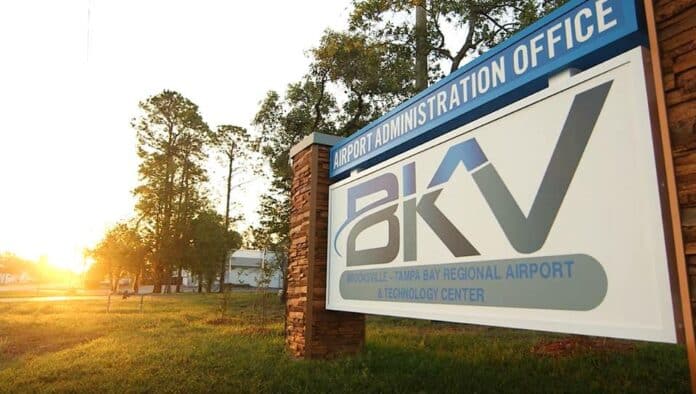A September 2023 briefing for the Committees on Armed Services of the Senate and the
House of Representatives on Per- and Polyfluoroalkyl Substances (PFAS) in
Groundwater lists the Brooksville Airport as one of 707 Department of Defence (DoD) installations and National Guard facilities that have known use or potential release of PFAS, which could contaminate groundwater. The site’s “Remedial Investigation Status” is listed as “Planned.”
The National Guard at the Brooksville airport had Perfluorooctane sulfonic acid (PFOS)-based aqueous film-forming foam (AFFF), which is a fire suppressant used to put out flammable liquid fires. PFOS is a type of PFAS chemical and resists grease, oil, heat and water,” which is why it is used to make foam to fight jet fuel fires. The foam can form a barrier between the fuel and oxygen starving the fire. In Agilent’s Material Safety Data Sheet, the PFOS hazard category is listed as “Acute toxicity (3.1), Flammable liquids (2.6), Specific target organ toxicity – single exposure (3.8)”
PFAS chemicals are very stable and take a very long time to break down which is why they are often referred to as forever chemicals. PFAS chemicals in drinking water is a major concern. A study by the National Health and Nutrition Examination Survey (NHANES) found “PFAS in the blood of 97 percent of Americans.”
PFAS is such a widespread problem because there are numerous everyday sources of PFAS, such as our water, clothing, cosmetics and even our air, explained local naturopathic medical doctor Maria Scunziano Singh. PFAS bioaccumulates in the body, disrupting hormones, metabolism, sexual function, immune system, liver function, nervous system and more.
She says that, for the most part, environmental intoxication from substances like PFAS is addressed by integrative physicians and naturopaths rather than mainstream medical professionals.
“They (medical professionals) are not really going there,” she said.
Additionally, according to Scunziano-Singh, “the burden is on the consumer.” They need to be aware that the regulatory agencies are not doing their jobs and she urges consumers to take precautions to protect their health, like installing water filtration systems, eating organic foods and replacing Teflon cookware. PFAS is just one of many harmful chemicals in the products we use every day.
The Centers for Disease Control and Prevention reported that “animal studies have found that PFAS can cause damage to the liver and the immune system.” They also state that these studies were generally done with higher dosages of PFAS than from usual environmental exposure.
The Environmental Protection Agency’s (EPA) drinking water standard is 4 parts per trillion (ppt) for PFOS. The DoD is currently working to ensure that no one is drinking water with PFOS or PFOA above 70 ppt and plans to implement the new stricter EPA standards as well. The DOD report estimates “$355.8 million to investigate and $379.0 million to clean up PFAS.”
The DoD reviewed several areas at the National Guard section at the Brooksville airport. After interviews and reviewing records, it was determined that two areas—the wash rack area and the AFFF spill area — might have PFAS contamination.
The Wash Rack Area was the site of the “annual nozzle testing of the TriMax units… conducted at the wash rack in January 2007 and February 2008. The unit tanks were emptied and discharged on the wash rack area.” The resulting mixture was then run through an oil/water separator and the water was drained into the sanitary sewer. A little while after the February 2008 test the remaining units were decommissioned and removed.
The AFFF Spill Area is near the #2 hanger. This hanger has an AFFF fire suppression system. There was a spill during the 2002-2003 installation of the system by Cox Fire. The spill was around five gallons and went from the pavement behind the hanger into a grassy area.
The finding of the preliminary assessment was “based on potential PFAS releases at these AOIs (Areas of Interest), there is potential for exposure to PFAS contamination in media at or near the facility.” The AOIs are the wash rack area and the AFFF Spill Area. The recommendation for both of the areas is to “proceed to an SI (Site Inspection), focus on soil and groundwater.”
The Hernando Sun will continue to follow this story. We are requesting the results of the Site Inspections and will let the public know what is found.

